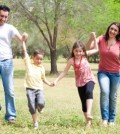Stats on U.S. Families: Characteristics, Changes, and Issues

Family Organization
Traditional: extended family form, power resided in elders, kin-group located near, married into kin groups with similar norms, constant from one generation to the next (orderly replacement)
Pluralism: many and varied forms of marital and family organization
Marriage becomes a personal issue rather than a kinship one
Free-choice rather than arranged marriages
Multiple number of acceptable forms of marriage and family (pluralistic nature)
Benefits for Same-Sex Domestic Partners (p.123)
First at Wayne State University (1995)
(Image courtesy of Stuart Miles/FreeDigitalPhotos.net)
Family Functions
Traditional functions
Familism over individualism, education should be centered in the home, children should care for their aging parents, prayer and religious rituals should be basic parts of daily family life, recreation should involve the family as a unit, and affection should be shared relatively exclusively among family members.
Emergent normsà performed by other agencies: economic factory and office, prestige and status with individual family member rather than reputation, teachers and day-care (substitute parents), police, reform schools, Social Security, Medicare and Medicaid, unemployment compensation, professional priests, rabbis, and clergy, source of recreation, and affection found elsewhere.
Emotional support à family and peer groups
Stabilization of adults and socialization of members
Marital- and Gender-Role Differentiation
Traditionally – no difficulty
Characteristics of U.S. Families
Population about 275 million (2000)
White 82.2%
Black 12.8%
American Indian/Eskimo/Aleut .9%
Asian or Pacific Islander 4.1%
Numbers of Families and Households
72 million family households (2000)
55.3 million married couples
4.0 million male householder/no wife present
12.7 million female householder/no husband present
Household: all persons who occupy a housing unit
104.7 million households
Sizes of Families and Households
Persons who are living together and are related by birth, marriage, or adoption
Average size 3.24 persons in 2000
White 3.13 persons
Black 3.41
Hispanic 3.94
Household 2.62 persons
Shortage of household space
Marital Status
Married, single, widowed, or divorced
Women are more likely than men to be widowed or divorced
Marriage continues to be popular
Nonmarried – premarital status for young; postmarital status for older
Most are married
When divorce – most remarry
Family Income
Median $50,891 (2000)
$9,867 (1970)
White $53,256
Hispanic $35,050
Black $34,204
Male householder/no wife $37,523
Female householder/no husband $25,787
Married with wife in the paid labor force $69,467
Higher: Northeast and bachelor’s degree
Today’s Families: Significant Changes (Census data)
Demographics
Female labor force increased
Average number of person per household decreased
Increase in never married
Delay in the median age at marriage
Divorce
Persons living below the official government poverty level decreased
Families living below poverty level increased
Median age of first marriage increased
Interracial married couples
Unmarried couples lived together
Childless
Births to unmarried women increased
Life expectancy
Living alone
Ideal-type constructs: extremes – continuum
Ideal type: standard with which to assess what any phenomenon would be if it always or never conformed to its own definition
Issues in U.S. Families
Arland Thornton: three decades of changing norms and values – American family (1950s-1980s)
Weakening of the imperatives to marry, to remain married, to have children, to restrict intimate relations to marriage, and to maintain separate roles for males and females
Away from traditional attitudes
Less committed to traditional family patterns
Meaning of Marriage and the Family
Sources of authority in marital an family decisions
Family as sacred
Traditional and nontraditional norms (p.120)
Social obligations: maintain social respectability, conform to kin and community wishes, and maintain a proper image within society.
Individual: concern with me
Marriage is sacred, social contract and success is viewed in terms of conformity to societal demands, marriage is highly personal, highly individualistic
Marital- and Gender-Role Differentiation
Traditionally – no difficulty
Patriarchal family – religious fundamentalist groups
Hierarchy of power
Androgyny (no gender-role differentiation) has not been achieved
Equal partners
Egalitarian-type marriage
Gender-Role Changes over Five Decades (p.125)
The Gallup Poll Monthly (1997) woman has a more difficult life
Household duties and housework
Family Change in Sweden (p.127)
Industrialization – work structure
Partner Selection
Traditionally – arranged marriages more prevalent
Traditional norms today à parents give their approval (permission)
Many choose according to whether or not he/she will meet parents’ approval
In-group (endogamous) selection: one’s own social class, religion, racial, ethnic, or neighborhood group
Outsider à future marital problems
Out-group (exogamous selection) à increasingly common
Love
Social construction of love
Is love necessary for marriage?
Intensity?
Exclusiveness of love relationships
Conflicting view: cannot and perhaps need not meet all of a partner’s intimacy needs
Sexual Relationships
Limited to marriage
Double standard
Prior to the turn of the twentieth century – taboo
Now mores
Sex separated from reproduction – source of pleasure for both sexes
Premarital cohabitation
Same-sex liaisons
Sexual norms
Family Size and Family Planning
Determining whether to have children
Determining how many to have and when
Selecting the appropriate means to accomplish these ends
One-child families
Population shifts when families removed form farms – children less of an economic asset
Current norm à maximum number should be two or three
4-6 is too many
And 10-14 is disastrous
Socially acceptable to have only one child or even no children
TRADITIONAL sacred NORMS – Abortion was never an option
Fertility control – legitimate
Family-size limitation – individual choice
Aged Family Members
Traditional – deference, respect, and recognition
Prestige, experience, and wisdom
Violence and Abuse among Intimates
Family Permanence
Permanent, lifelong commitment, or temporary, situational arrangements
Sacred – lasts until death (celestial marriage)
Disorganization and reorganization
Divorce – traditionally – one party had to be at fault
Norval Glenn: when people have the option or are encouraged to end unsatisfactory relationships, existing marriages become so insecure that rational people will not invest a great deal of time, energy, or money in such unions
Other Contemporary Issues
Social policy, social problems, pollution, health care, taxation, immigration, affirmative action, student loans, school prayer, burning the flag, the homeless, crime, terrorism, …
Social events, social circumstances, and social policies influence people’s behaviors and lifestyles.
About admin
Teaching Sociology is very enjoyable for me. Sociology is like a gateway to a plethora of knowledge and understanding. The subject material is directly applicable to real-world events and situations found in everyday life. The methods and concepts of sociology yield powerful insights into the social processes shaping the contemporary world. The ability to identify and understand these processes is valuable preparation for professional participation in an ever changing and complex society.Related Posts
Latest News
-
Sociology and the Pursuit of Social Justice: A Compelling Reason to Study It
Sociology is a fascinating field of study that delves into...
- Posted May 31, 2023
- 0
-
The Power of Sociology: Understanding the Importance of Social Structures
Sociology is the scientific study of society, social relationships, and...
- Posted May 31, 2023
- 0
-
FACT FINDING MISSIONS
Life is interleaved with contracts and agreements, the formal and...
- Posted August 10, 2018
- 0
-
The Many Churches of Enhancement
Throughout history religions formed around prophetic doctrines and absorbed people...
- Posted April 6, 2018
- 0
-
TAKE A SECOND TO CONSIDER THE SECOND
Remember that during the late 1700’s when the young US...
- Posted February 21, 2018
- 0
-
WHAT’S ON THE TABLE FOR IMMIGRATION
Deliberating in upcoming months will be a new proposal for...
- Posted February 12, 2018
- 0
-
Time-saving Tips from Your Instructor
Here are some helpful tips: Involve your family/friends. Let them...
- Posted October 19, 2016
- 0
-
Sociology and the Pursuit of Social Justice: A Compelling Reason to Study It
Sociology is a fascinating field of study that delves...
- May 31, 2023
- 0
-
The Power of Sociology: Understanding the Importance of Social Structures
Sociology is the scientific study of society, social relationships,...
- May 31, 2023
- 0
-
FACT FINDING MISSIONS
Life is interleaved with contracts and agreements, the formal...
- August 10, 2018
- 0
-
Successful Families
SUCCESSFUL FAMILIES Balancing Work and Family (dual-earner families) 1.Value...
- June 16, 2011
- 0
-
Sociology of Marriage
Types of “Good” Marriages: Romantic Marriage: passion and sex...
- June 16, 2011
- 0
Sociological Theory
-
Symbolic Interactionism
Symbolic interactionism focuses on how individuals communicate with one another, the basis...








